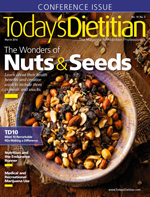 March 2016 Issue
March 2016 Issue
Ask the Expert: The Raw Food Diet
By Toby Amidor, MS, RD, CDN
Today's Dietitian
Vol. 18 No. 3 P. 10
Q: Some of my clients are following a raw food diet, and others are asking about it. What does this diet entail, and are there any benefits to eating raw foods?
A: The theory behind this diet is that raw foods are packed with natural enzymes, and that if they're cooked above 116° F, the heat will destroy most of the vitamins, phytonutrients, and enzymes in foods like cauliflower and broccoli. Although weight loss is likely on a raw food diet due to the diet's low-calorie status and the elimination of high-calorie processed food, cooked food has nutritional and safety benefits.
Raw foodism goes back to the 1800s when one of the first proponents, Swiss-born Maximilian Oskar Bircher-Benner, claimed that eating raw apples helped cure his mild case of jaundice. He then conducted experiments with raw food and later opened a clinic in dietetics to teach his methods. The popularity of the raw food diet has since spread and evolved over the years. The diet includes fresh fruit, vegetables, nuts, seeds, and herbs. No food can be cooked above 116° F, microwaved, processed, irradiated, genetically modified, or exposed to herbicides or pesticides. Some followers add raw, unpasteurized milk or cheese made from raw milk; raw honey; raw fish; and even raw meat. Legumes and grains are eaten raw, like chickpeas and mung beans. Other allowable foods include extra-virgin olive oil, raw virgin coconut oil, raw coconut butter, freshly squeezed juice, and herbal tea. Foods that are off limits include refined sugars and flours, table salt, and caffeine. Pasta, baked goods, and pasteurized juice and milk also are prohibited.
Followers can use juicing, blending, dehydrating, germinating, and sprouting to prepare foods. However, some of the required equipment, such as dehydrators, food processors, and high-grade blenders, are costly.
The Issues
Although followers of the raw food diet tend to lose weight, long-term followers put their health at risk. A study published in the Annals of Nutrition & Metabolism followed 513 men and women for just under four years.1 Subjects were divided into five groups based on how much raw food was included in their diet; total calories weren't measured. The men lost 9.9 kg (21.8 lbs), and the women lost 12 kg (26.5 lbs), on average. BMI was below normal weight range in 14.7% and 25% of the men and women, respectively. About 30% of the women younger than age 45 had partial to complete amenorrhea, and those with high amounts of raw food in their diet (>90%) were affected more frequently than those who consumed raw foods moderately.
Food safety is a second issue to consider. Unpasteurized dairy has a history of transmitting Listeria, which can be detrimental to the health of pregnant women and could potentially lead to stillbirth. Raw meat can contain bacteria such as E coli O157:H7, which is potentially deadly.
Further, the theory that raw food has a nutritional advantage over cooked food is unfounded. A 2002 study found that the antioxidant lycopene is released from tomatoes when they're cooked.2 A 2008 study published in The British Journal of Nutrition found that German subjects following a long-term raw food diet had low levels of lycopene.3 Mushrooms and asparagus also have advantages when cooked. Per the USDA Nutrient Database, cooked mushrooms contain higher amounts of niacin, potassium, and zinc compared with the same weight of fresh mushrooms. A 2009 study also found that cooking asparagus increased the phytochemicals quercetin, lutein, and zeaxantin.4 As such, raw foodies aren't completely wrong in saying that cooking can destroy enzymes and nutrients. For example, it's well known that vitamin C is easily destroyed when cooked. From a nutrition standpoint, a combination of both raw and cooked food provides the most health benefits.
There's also a risk of nutrient deficiency when raw food enthusiasts don't consume dairy, meat, or fish. Plus, certain foods like beans and grains typically aren't eaten since they need to be cooked; this can lead to additional deficiencies if the nutrients aren't obtained through other sources or supplementation.
Client Recommendations
A raw food diet can promote weight loss; however, there can be nutritional and health consequences associated with eliminating cooked foods. If a client would like to follow a raw food diet, recommend they follow it to a lesser extent (no more than 90% raw foods) and to include cooked food as part of a well-balanced and varied diet.
— Toby Amidor, MS, RD, CDN, is the founder of Toby Amidor Nutrition (http://tobyamidornutrition.com) and the author of the cookbook The Greek Yogurt Kitchen: More Than 130 Delicious, Healthy Recipes for Every Meal of the Day. She's also a nutrition expert for FoodNetwork.com and a contributor to US News Eat + Run, Shape.com, and MensFitness.com.
References
1. Koebnick C, Strassner C, Hoffmann I, Leitzmann C. Consequences of a long-term raw food diet on body weight and menstruation: results of a questionnaire survey. Ann Nutr Metab. 1999;43(2):69-79.
2. Dewanto V, Wu X, Adom KK, Liu RH. Thermal processing enhances the nutritional value of tomatoes by increasing total antioxidant activity. J Agric Food Chem. 2002;50(10):3010-3014.
3. Garcia AL, Koebnick C, Dagnelie PC, et al. Long-term strict raw food diet is associated with favourable plasma beta-carotene and low plasma lycopene concentrations in Germans. Br J Nutr. 2008;99(6):1293-1300.
4. Fanasca S, Rouphael Y, Venneria E, Azzini E, Durazzo A, Maiani G. Antioxidant properties of raw and cooked spears of green asparagus cultivars. Int J Food Sci Technol. 2009;44(5):1017-1023.